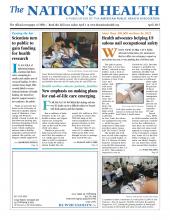When New York City Public Advocate Letitia James, JD, announced that her office was releasing a report on nail salons last year, it was anything but a frivolous task.
The policy report, “How Safe is Your Nail Salon?,” released in September, took a look at health and safety practices for both consumers and workers in New York City’s nail salons. And with more than 2,000 businesses licensed to do manicures and pedicures in the city alone, the health of a large swath of the public is affected. In New York, the salons are regulated by the state — which has just 27 inspectors to help maintain their safety, James told The Nation’s Health.

Nail salon workers are often exposed to chemicals that have been linked to health issues.
Photo courtesy PeterTG, iStockphoto
The health and wellness of nail salon employees is no small matter, as the U.S. Bureau of Labor Statistics estimated there were 86,900 manicurists and pedicurists in the U.S. in 2012. That number is expected to rise to 100,400 by 2022. But that estimate is probably far too low, according to the California Healthy Nail Salon Collaborative, which estimates there are 97,100 manicurists in California alone right now. Up to 80 percent of those workers are Vietnamese immigrants, and more than 50 percent are women of reproductive age.

A customer receives a manicure at a nail salon in 2006 in San Francisco. The city passed a Healthy Nail Salon Recognition Program in 2012, joining the growing number of municipalities focusing on the health and safety of nail salon workers.
Photo by Justin Sullivan, courtesy Getty Images
Duyen Tran, MPH, an APHA member and the interim outreach coordinator for the collaborative, says there are several reasons that nail salon work appeals to young women in the Vietnamese community. Some of it is the flexibility working in a nail salon can afford: Employees can tailor their schedules around their families’ needs. Another reason is the ease with which a worker can enter into the industry and start making money. Training courses, which are 12 to 18 months long, and exams are offered in Vietnamese.
“To do nail salon work you don’t need high English proficiency,” Tran told The Nation’s Health. “It doesn’t require intensive English training, so it’s really an opportunity for this recent immigrant population to enter the workforce and use it to support their families and communities in a very short time.”
But joining the workforce means exposure to known dangerous products — and potentially unknown dangers, as well.
Three chemicals pose most risks to workers
The biggest risks to nail salon workers are “the toxic trio:” Toluene, formaldehyde and dibutyl phthalate are the most common and dangerous ingredients in nail products, including polish and polish remover, that have been linked to serious health risks. According to the Centers for Disease Control and Prevention, toluene exposure has been linked to tiredness, confusion, weakness, drunken-type actions, memory loss, nausea, loss of appetite and hearing and color vision loss. High levels of exposure have been linked to kidney damage.
Formaldehyde exposure can lead to irritation of the eyes, nose and throat, causing tearing, and skin irritation, according to CDC, and is a known carcinogen. CDC’s Agency for Toxic Substances and Disease Registry notes that dibutyl phthalate is linked to organ development issues in fetuses when exposed during gestation.
The toxic trio can be transmitted as airborne particles, through product contact with skin or eyes and via unintentional transfer of the materials to uncovered food, drink or cigarettes, according to research from the California Healthy Nail Salon Collaborative. The Occupational Safety and Health Administration has reported that chemical levels can exceed 826 parts per million during the application of acrylics in nail salons, but proper ventilation can drop that to 12.4 parts per million.

Nadia, a spa worker, gives a customer a pedicure in New York City in 2003. As of 2012, there were 86,900 manicurists and pedicurists in the U.S., according to the U.S. Bureau of Labor Statistics. Such workers can be exposed to on-the-job hazards.
Photo by Stephen Chernin, courtesy Getty Images
Despite these risks, in Nails Magazine’s 2014-15 report, “Nails Big Book: Everything You Need to Know About the Nail Industry,” 34 percent of nail salon workers reported that they never wear protective gloves while working. Sixty-one percent said they never wear a mask while working. And more than half reported having work-related health concerns. Twenty-three percent said they were uninsured.
Salons can promote safety for workers
Though self-reported low numbers of nail salon workers take safety precautions, state and federal government regulations require certain steps to be taken to ensure worker safety. OSHA distributes “Stay Healthy and Safe While Giving Manicures and Pedicures: A Guide for Nail Salon Workers,” which outlines workers’ rights to health and safety for both employees and salon owners. The guide has been translated to Vietnamese, Spanish and Korean. And OSHA has been working to reach out to communities to make sure workers’ rights are well-known, said Mandy Edens, MSPH, director of OSHA’s directorate for technical support and emergency management.
“Our mission is to make sure that employers understand their obligations under the Occupational Safety and Health Act, that they have the tools to protect the workers from their various hazards,” Edens told The Nation’s Health. “We have an obligation to help employees understand their rights under the Occupational Safety and Health Act. If they believe their employer isn’t following OSHA rules, they…have the right not to be retaliated against. We have a lot of whistleblower rules, so they should feel both of those things will go to helping improve safety and health in the workplace.”
Some cities are taking worker safety enforcement a step further. San Francisco’s Department of Environment created a Healthy Nail Salon Program in 2012. Boston’s Board of Health enabled its public health commission to regulate the city’s nail salons in 2011. And now the Office of the New York City Public Advocate is calling for multiple improvements for the health of its nail salon workers, including:
an incentive program that would provide grants for salon owners to improve ventilation after completing a safety program,
a “green seal” incentive program that would recognize nail salons that have made health improvements,
a citywide safety study of salons and workers’ health, and
city jurisdiction to investigate and perform nail salon inspections, rather than the state.
“We’re working with public health workers, advocates and legislators with regard to this issue,” James told The Nation’s Health. “This is an important conversation.”
Tran also noted that public health advocates can help make their local salons safer by asking for healthier options, and encouraging their workers to take steps such as wearing gloves or masks.
The collaborative also offers a list of 10 steps a salon can take to be a healthy and safe workplace, which customers can share with their salons, Tran said.
“When you come to a salon…you can advocate for safer products (to) be used in salons, so it drives up demand, so workers and owners purchase more of those products,” Tran told The Nation’s Health. “Share this information with them and really get them educated and interested in this topic. Even if there’s no (local) program to support them, they can put them in practice on an individual or salon-based level across the country.”
To get the list or learn more, visit www.cahealthynailsalons.org.
- Copyright The Nation’s Health, American Public Health Association









